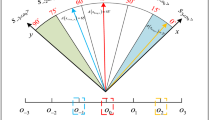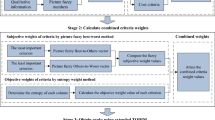Abstract
Constructing scientific evaluation system and evaluation methods to make timely quantitative evaluation for regional industrial operation quality is of great practical significance for expediting the new industrialization process and promoting the improvement of national economic operation quality. Aiming at the problem of evaluating the industrial operation quality, this paper constructs a new evaluation system from the perspective of industrial operation performance and industrial development potential, and then proposes a multi-source heterogeneous multi-attribute decision-making method based on the linguistic 2-tuple model to evaluate the industrial operation quality. In this method, the original multi-source heterogeneous data whereby real numbers, interval numbers, and linguistic fuzzy numbers coexist are all transformed into linguistic 2-tuples, then a new ranking method based on grey relational degree of linguistic 2-tuple matrix is presented to rank the level of industrial operation quality for the given cities. Further, a decision-making example of evaluating the industrial operation quality for 14 cities in Hunan Province of China is provided to highlight the implementation, availability, and feasibility of the proposed evaluation model.
Similar content being viewed by others
References
Staron, M., Meding, W., Nilsson, C.: A framework for developing measurement systems and its industrial evaluation. Inf. Softw. Technol. 51, 721–737 (2009)
Lv, Z.K., Xu, T.: Is economic globalization good or bad for the environmental quality? New evidence from dynamic heterogeneous panel models. Technol. Forecast. Soc. Chang. 137, 340–343 (2018)
Coulibaly, S.K., Erbao, C., MetugeMekongcho, T.: Economic globalization, entrepreneurship, and development. Technol. Forecast. Soc. Chang. 127, 271–280 (2018)
Rao, C.J., Zhao, Y., Zheng, J.J., Wang, C., Chen, Z.W.: An extended uniform-price auction mechanism of homogeneous divisible goods: supply optimisation and non-strategic bidding. Int. J. Prod. Res. 54(13), 4028–4042 (2016)
Liang, Y.Y., Liu, J., Qin, J.D., Tu, Y.: An improved multi-granularity interval 2-tuple TODIM approach and its application to green supplier selection. Int. J. Fuzzy Syst. 21(1), 129–144 (2019)
Arbolino, R., Boffardi, R., Lanuzza, F., Ioppolo, G.: Monitoring and evaluation of regional industrial sustainability: evidence from Italian regions. Land Use Policy 75, 420–428 (2018)
Wang, B.X.: Study on Construction of Industrial Economic Operation Quality Evaluation System in Yunnan Province. Master Degree Thesis of Yunnan University (2015)
Bian, Y.W., Liang, N.N., Xu, H.: Efficiency evaluation of Chinese regional industrial systems with undesirable factors using a two-stage slacks-based measure approach. J. Cleaner Prod. 87, 348–356 (2015)
Neri, A., Sebastiano, E., Trianni, A.: Industrial sustainability: modelling drivers and mechanisms with barriers. J. Cleaner Prod. 194, 452–472 (2018)
Luh, Y.H., Jiang, W.J., Huang, S.C.: Trade-related spillovers and industrial competitiveness: exploring the linkages for OECD countries. Econ. Model. 54, 309–325 (2016)
UNIDO: Industrial Development Report 2011—Industrial Energy Efficiency for Sustainable Wealth Creation: Capturing Environmental, Economic and Social Dividends (2011)
Luthra, S., Mangla, S.K.: Evaluating challenges to Industry 4.0 initiatives for supply chain sustainability in emerging economies. Process Saf. Environ. Protect. 117, 168–179 (2018)
Bhowmik, C., Bhowmik, S., Ray, A.: Social acceptance of green energy determinants using principal component analysis. Energy 160(1), 1030–1046 (2018)
Wang, Z.X., Wang, Y.Y.: Evaluation of the provincial competitiveness of the Chinese high-tech industry using an improved TOPSIS method. Expert Syst. Appl. 41, 2824–2831 (2014)
Fu, Z.G., Liao, H.C.: Unbalanced double hierarchy linguistic term set: the TOPSIS method for multi-expert qualitative decision making involving green mine selection. Inf. Fusion 51, 271–286 (2019)
Yang, S.L., Bai, Y., Wang, S.F., Feng, N.P.: Evaluating the transformation of China’s industrial development mode during 2000–2009. Renew. Sustain. Energy Rev. 20, 585–594 (2013)
Ghasemi, E., Aaghaie, A., Cudney, E.A.: Mahalanobis Taguchi System: a review. Int. J. Qual. Reliab. Manag. 32(3), 291–307 (2015)
Wan, S.P., Wang, Q.Y., Dong, J.Y.: The extended VIKOR method for multi-attribute group decision making with triangular intuitionistic fuzzy numbers. Knowl.-Based Syst. 52, 65–77 (2013)
Mokhtarian, M.N., Sadi-nezhad, S., Makui, A.: A new flexible and reliable interval valued fuzzy VIKOR method based on uncertainty risk reduction in decision making process: an application for determining a suitable location for digging some pits for municipal wet waste landfill. Comput. Ind. Eng. 78, 213–233 (2014)
Rao, C.J., Goh, M., Zheng, J.J.: Decision mechanism for supplier selection under sustainability. Int. J. Inf. Technol. Decis. Making 16(1), 87–115 (2017)
Rao, C.J., Xiao, X.P., Goh, M., Zheng, J.J., Wen, J.H.: Compound mechanism design of supplier selection based on multi-attribute auction and risk management of supply chain. Comput. Ind. Eng. 105, 63–75 (2017)
Liao, H.C., Xu, Z.S., Herrera-Viedma, E., Herrera, F.: Hesitant fuzzy linguistic term set and its application in decision making: a state-of-the art survey. Int. J. Fuzzy Syst. 20(7), 2084–2110 (2018)
Liu, P.D., Rong, L.L.: Multiple attribute group decision-making approach based on multi-granular unbalanced hesitant fuzzy linguistic information. Int. J. Fuzzy Syst. (2019). https://doi.org/10.1007/s40815-019-00672-4. (in press)
Liao, H.C., Tang, M., Zhang, X.L., Al-Barakati, A.: Detecting and visualizing in the field of hesitant fuzzy sets: a bibliometric analysis from 2009 to 2018. Int. J. Fuzzy Syst. 21(5), 1289–1305 (2019)
Peng, J.J., Wang, J.Q., Wu, X.H.: Extended ELECTRE I method with multi-hesitant fuzzy information. Int. J. Fuzzy Syst. (2019). https://doi.org/10.1007/s40815-019-00716-9. (in press)
Liao, H.C., Mi, X.M., Yu, Q., Luo, L.: Hospital performance evaluation by a hesitant fuzzy linguistic best worst method with inconsistency repairing. J. Cleaner Prod. 232(20), 657–671 (2019)
Liao, H.C., Wu, X.L.: DNMA: a double normalization-based multiple aggregation method for multi-expert multi-criteria decision making. Omega (2019). https://doi.org/10.1016/j.omega.2019.04.001. (in press)
Bakhshi, H., Edwards, J.S., Roper, S., Scully, J., Shaw, D., Morley, L., Rathbone, N.: Assessing an experimental approach to industrial policy evaluation: applying RCT+ to the case of Creative Credits. Res. Policy 44, 1462–1472 (2015)
Li, Z.Y., Yang, T., Huang, C.H., Xu, C.Y., Shao, Q.X., Shi, P.F., Wang, X.Y., Cui, T.: An improved approach for water quality evaluation: TOPSIS-based informative weighting and ranking (TIWR) approach. Ecol. Ind. 89, 356–364 (2018)
Ren, Z.L., Xu, Z.S., Wang, H.: Normal wiggly hesitant fuzzy sets and their application to environmental quality evaluation. Knowl. Based Syst. (2019). https://doi.org/10.1016/j.knosys.2018.06.024. (in press)
Govindan, K., Shankar, K.M., Kannan, D.: Application of fuzzy analytic network process for barrier evaluation in automotive parts remanufacturing towards cleaner production—a study in an Indian scenario. J. Cleaner Prod. 114, 199–213 (2016)
Liu, W.J., Zhang, J., Jin, M.Z., Liu, S.F., Chang, X.Y., Xie, N.M., Wang, Y.T.: Key indices of the remanufacturing industry in China using a combined method of grey incidence analysis and grey clustering. J. Cleaner Prod. 168, 1348–1357 (2017)
Liu, W.J., Wu, C., Chang, X., Chen, Y., Liu, S.F.: Evaluating remanufacturing industry of China using an improved grey fixed weight clustering method-a case of Jiangsu Province. J. Cleaner Prod. 142, 2006–2020 (2017)
Liu, X., Tao, Z.F., Chen, H.Y., Zhou, L.G.: A new interval-valued 2-tuple linguistic bonferroni mean operator and its application to multiattribute group decision making. Int. J. Fuzzy Syst. 19(1), 86–108 (2017)
Rao, C.J., Goh, M., Zhao, Y., Zheng, J.J.: Location selection of city logistics centers under sustainability. Transport. Res. D 36, 29–44 (2015)
Luo, W., Xu, G.R.: A study on China’s industry development quality. China Soft Sci. 1, 50–60 (2013)
Estorilio, C., Vaz, G., Lisboa, F., Bessa, L.: The relationship between industrial process maturity and quality certification. Comput. Stand. Interfaces 39, 22–33 (2015)
Noroozi, S., Wikner, J.: Sales and operations planning in the process industry: a literature review. Int. J. Prod. Econ. 188, 139–155 (2017)
Mumtaz, U., Ali, Y., Petrillo, A.: A linear regression approach to evaluate the green supply chain management impact on industrial organizational performance. Sci. Total Environ. 624, 162–169 (2018)
Haydo, P.A.: From morphological analysis to optimizing complex industrial operation scenarios. Technol. Forecast. Soc. Chang. 126, 147–160 (2018)
Rao, C.J., Zheng, J.J., Wang, C., Xiao, X.P.: A hybrid multi-attribute group decision making method based on grey linguistic 2-tuple. Iran. J. Fuzzy Syst. 13(2), 37–59 (2016)
Chen, L., Peng, J., Liu, Z.B., Zhao, R.Q.: Pricing and effort decisions for a supply chain with uncertain information. Int. J. Prod. Res. 55(1), 264–284 (2017)
Liu, Z.B., Zhao, R.Q., Liu, X.Y., Chen, L.: Contract designing for a supply chain with uncertain information based on confidence level. Appl. Soft Comput. 56, 617–631 (2017)
Herrera, F., Martinez, L.: A 2-tuple fuzzy linguistic representation model for computing with words. IEEE Trans. Fuzzy Syst. 8(6), 746–752 (2000)
Herrera, F.: A model based on linguistic 2-tuple for dealing with multi-granularity hierarchical linguistic contexts in multi-expert decision-making. IEEE Trans. Syst. Man Cybern. B 31(2), 227–234 (2001)
Park, J.H., Park, J.M., Kwun, Y.C.: 2-tuple linguistic harmonic operators and their applications in group decision making. Knowl.-Based Syst. 44, 10–19 (2013)
Herrera, F., Martinez, L., Sanchez, P.J.: Managing non-homogeneous information in group decision making. Eur. J. Oper. Res. 166(11), 115–132 (2005)
Xiao, X.P., Song, Z.M., Li, F.: Grey technology and its application. Science Press, Beijing (2005)
Deng, J.L.: Grey forecasting and grey decision-making. HUST Press, Wuhan (2002)
Yue, Z.L.: An extended TOPSIS for determining weights of decision makers with interval numbers. Knowl.-Based Syst. 24(1), 146–153 (2011)
Wei, G.W.: Grey relational analysis method for 2-tuple linguistic multiple attribute group decision making with incomplete weight information. Expert Syst. Appl. 38, 4824–4828 (2011)
Li, G.X., Kou, G., Peng, Y.: A group decision making model for integrating heterogeneous Information. IEEE Trans. Syst. Man Cybern. 48(6), 982–992 (2015)
Tang, M., Zhou, X.Y., Liao, H.C., et al.: Ordinal consensus measure with objective threshold for heterogeneous large-scale group decision making. Knowl.-Based Syst. 180, 62–74 (2019)
Acknowledgements
This work is partially supported by the National Natural Science Foundation of China (Grant Nos. 71871174, 71671135), and the Fundamental Research Funds for the Central Universities (WUT: 2019IB013).
Author information
Authors and Affiliations
Corresponding author
Rights and permissions
About this article
Cite this article
Xiao, Q., Shan, M., Xiao, X. et al. Evaluation Model of Industrial Operation Quality Under Multi-source Heterogeneous Data Information. Int. J. Fuzzy Syst. 22, 522–547 (2020). https://doi.org/10.1007/s40815-019-00776-x
Received:
Revised:
Accepted:
Published:
Issue Date:
DOI: https://doi.org/10.1007/s40815-019-00776-x




